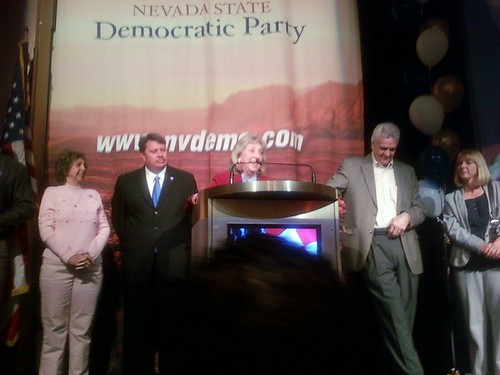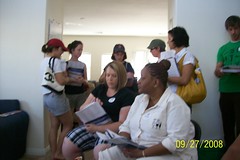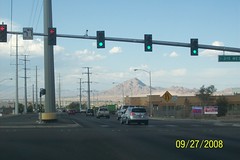Episode 2 in my series of diaries mapping out possible redistricting scenarios in the states has arrived! Today, I map Michigan and Nevada.
Grain of salt alert: my districts are based on county estimates from 2007 which are due to be adjusted soon with 2008 numbers. Also, I am using projected seat totals that are equally subject to change.
The number geeks among us will really enjoy what’s below the fold…
Michigan
The battle for control of redistricting in Michigan is wide open in the 2010 elections, with a competitive open race for the governor’s mansion being vacated by term-limited Democrat Jennifer Granholm and the state Senate standing at a narrow 21-17 Republican advantage. Since Democrats have a strong 67-43 edge in the House, the one scenario that seems unlikely is a repeat of 2001’s GOP gerrymander. Given the difficulty of both holding Granholm’s spot and picking up those three Senate seats, my best bet would be a continuation of split redistricting power when map-making time comes around in 2011-2012…and usually, split control means incumbent protection.
But hark, Michigan is expected to lose a seat in redistricting, going from 15 down to 14. Someone will have to be the unlucky loser. If Democrats somehow won the trifecta, they could force two GOP incumbents (say, Mike Rogers and Dave Camp) to run against each other. But since I’m presuming split control, it will have to be a Republican against a Democrat.
At first, the logical choice seemed to be eliminating Thad McCotter by pitting him against longtimer Sander Levin. But I decided against this for a very good reason: Gary Peters must be protected in any plan, and since Oakland County is a relatively competitive county, its Republican voters have to go somewhere. So if McCotter and Levin went against each other, it would likely have to be a GOP-leaning district, one a liberal like Levin would have trouble winning. Meanwhile, there was one incumbent other than Peters (Mark Schauer) whom I pointedly wanted to protect, and the only way to make him safe that I saw was to encroach on heavily Democratic Ingham County (Lansing). Thus the solution was reached: a Democratic-leaning 7th District that forces Schauer against Mike Rogers in a seat Schauer would likely win.
Would Republicans in the state Senate vote for such a plan? Well, they probably would if it protected the congressional delegation’s weakest GOP member, McCotter…and by giving him Livingston County, it does.
There is only one problematic side effect of my map: it pushes Sander Levin’s home out of the district in which he’d presumably run. I’m not clear whether his hometown of Royal Oak would be represented by Peters or McCotter, but his base would be shifted to working-class Democratic parts of Macomb and Wayne Counties. I’m sure he’d move if necessary; Michigan isn’t new to messy redistricting plans. In retrospect, I probably could have split Oakland County three ways and allowed Levin to stay put, but the way my map is configured, he’d need to pick up a lot of Macomb County’s Democrats anyway.
Without further ado, here it is:

District 1 – Bart Stupak (D-Menominee) — I think I finally found the way to make his district relatively strong for a future Democrat (face it, some day, 10 to 15 years down the road, Stupak will retire, and the Upper Peninsula isn’t as Democratic as it once was): I gave Stupak 89% of Bay County, making Bay City the largest source of district population.
District 2 – Pete Hoekstra (R-Holland) — Hoekstra will likely run for Governor in 2010, but another conservative West Michigan Republican should succeed him, and that person will be plenty safe in 2012 under my plan.
District 3 – Vern Ehlers (R-Grand Rapids) — had to expand a little and take Kent County whole, but will remain strongly GOP-leaning.
District 4 – Dave Camp (R-Midland) — this thing stretches from Lake Michigan to the Saginaw area now because of lagging population, but it should stay strong for Camp and any credible Republican in most years.
District 5 – Dale Kildee (D-Flint) — like most of the state’s districts, this one had to expand geographically, taking much of Michigan’s Thumb from Candice Miller. With all of Genesee County intact, no doubt it stays a Democratic seat.
District 6 – Fred Upton (R-St. Joseph) — possibly became a bit more Republican by taking some of Mark Schauer’s more conservative turf, but not significantly so. Stays safe for Upton, competitive or slightly GOP-leaning in a future race.
District 7 – Mark Schauer (D-Battle Creek) vs. Mike Rogers (R-Brighton) — the horror of hard-right Rogers representing 66% Obama-supporting Ingham County is coming to an end! Rogers’ saving grace, heavily Republican Livingston County, is removed from the district as Ingham combines with Schauer’s less Democratic geographical base to make Rogers a goner. After 2012, Schauer could likely rely on Lansing more than Battle Creek or Jackson to get him reelected.
District 8 – Gary Peters (D-Bloomfield Township) — contained entirely within Oakland County, grabbing more Democratic areas from Sander Levin, who presumably has enough clout and seniority to make it in a modified but definitely Dem-friendly Macomb/Wayne district. As I said before, if there’s anything I would have done differently with this map, it’s keeping Levin in Oakland, but since these are based on 2007 county population estimates anyway, this plan is only a rough guideline of how I see redistricting going down in two or three years.
District 9 – Candice Miller (R-Harrison Township) — heavier in Macomb County, snatching its more Republican areas while only creeping a bit up the Thumb.
District 10 – Thad McCotter (R-Livonia) — he finally becomes safe, because no matter the trends in Oakland or Wayne, he’ll have Livingston County to keep him in Congress. It was a tough call figuring out which Republican would be hurt by redistricting, but as I mentioned, Oakland County is relatively 50/50 in neutral election years and those Republicans have to go somewhere…it’s far easier to imagine a bipartisan plan targeting Rogers, whose district is one of the truest gerrymanders in the state.
District 11 – Sander Levin (D-Royal Oak) — okay, maybe the legislature can find a way to keep him in Oakland County, but regardless, his district will stay safely Democratic (though it has to shed a few Dems for Peters’ sake).
District 12 – Carolyn Cheeks Kilpatrick (D-Detroit) — while population loss has been severe in Detroit, the Voting Rights Act as practiced today would seem to protect both Kilpatrick and Conyers. Her district will grow in area but should stay majority-black and overwhelmingly Democratic.
District 13 – John Conyers (D-Detroit) — ditto.
District 14 – John Dingell (D-Dearborn) — stays safely Democratic. When Dingell retires, it will be fascinating to see the primary battle play out between a Dingell-esque old-school “GM-approved candidate” and an Ann Arbor latte liberal.
Most likely result of this plan: 8 Democrats, 6 Republicans. While the Senate won’t like losing a Republican, the fact is that people like Upton, Rogers, and McCotter already represent districts that voted for Obama, so to cement GOP seats in the future, something’s gotta give. Saving McCotter should be enough of a consolation prize/sweetener to win Senate approval for a plan like this.
On to Nevada
Over the last decade, no state has represented a more different kind of America from Michigan than Nevada. While a slowdown in migration is currently resulting from the poor economy, and a “desert foreclosure crisis” has slowed Nevada’s growth to something of a halt compared to past years, the Silver State is still a lock for a new seat. As in Michigan, Democrats have a realistic chance at a takeover, but for now, control is split. 2010 will be a huge year in Nevada, with Harry Reid fighting for reelection, GOP Gov. Jim Gibbons badly unpopular, and term limits finally taking effect in the Democratic-controlled legislature. Gibbons’ approval ratings render him DOA either in the primary or the general, but the difference could be crucial. Term limits could help either party, and might affect control of the Senate, though the Assembly is lopsided enough to remain Democratic regardless.
In any case, while Democrats will gun for a shutout, the current state of affairs is split control, and I drew my map accordingly. What you’ll immediately notice is that the “cow counties” north of Las Vegas finally have not one, but two, districts representing them in Congress. Yet appearances can be deceiving; Dean Heller’s District 2 will actually be dominated by Reno and Carson City, while my proposed District 4 (likely a competitive seat) will have mixed turf in northern Clark County as its population base.

District 1 – Shelley Berkley (D-Las Vegas) — will probably become even tinier in area and stay solidly Democratic.
District 2 – Dean Heller (R-Carson City) — I tried my darnedest to protect Heller knowing that whether Democrats control the process or power is split, Heller will not be a target, but he will lose the southern part of his district no matter who draws the lines. In a Democratic wave year like 2008, this district would not look great for him what with Dem trends in Washoe County and Carson City, but if he can endear himself to Reno and hold strong at home, he should be fine.
District 3 – Dina Titus (D-Las Vegas) — will also contract and become more Democratic regardless who draws the lines.
And the new District 4 – stretches up from North Las Vegas to Elko County — this should be a competitive seat, with a Democratic-leaning Clark County base counterbalanced by Art Bell libertarians in Pahrump and cowboy conservatives up north. If Democrats manage to hold the Senate and win the governor’s mansion in 2010, they will seek to make the new 4th more Democratic than did I and further protect Heller in his increasingly centrist turf, but again, I’m assuming split control for now.
Net result: Berkley and Titus are safe, Heller is fine as long as he can win Reno, and a new wild card is introduced. The question is: is there any politician in Nevada who would know how to win over the suburbs of Las Vegas and Elko?
Episode 3 (coming soon): will cover Iowa and Ohio (two of my best)
Episode 4: New Jersey and Georgia
Episode 5: Florida and Louisiana
Episode 6: Pennsylvania and Utah
EDIT: Re: my Michigan plan, it seems that I inadvertently am forcing two Republicans against each other. Brighton is in Livingston County, not Ingham County. Very well, then, let Rogers and McCotter have each other out, but would Senate Republicans go for it? I would point out that a similar situation occurred in Indiana back in 2001 (the state lost a seat, and a Democratic Governor and House passed a plan — with approval from a Republican Senate — that forced GOPers Brian Kerns and Steve Buyer against each other).
























